I’ve recently taken a journey into the world of working dogs. As I wrote in my previous post on livestock guardian dogs, “I find it so interesting to watch them work, think about how they’re trained and see what they are capable of.”
When I think about working dogs, one of the jobs that first comes to mind is guide dog.
Most of us have seen a dog and handler at some point in our lives. However, beyond knowing I’m not supposed to pet a guide dog, I know very little about the work they do.
So, I reached out to Katrin Hawkins, a certified dog behaviour consultant who is also visually impaired, and asked her to share her experience and additional guide dog info.
Do you know a dog with an interesting job? Leave a comment or contact me at homeon129acres@hotmail.com, and they may be featured in an upcoming post.
Guide dog info – an introduction
Katrin and her husband live near Boston with her guide dog, Tom, and her Cardigan Welsh Corgi, Zora.
Tom is a 9-year-old Labrador Golden Retriever cross from the Guide Dog Foundation. Katrin and Tom have been a team for nearly 8 years (he was 19 months old when they were matched).
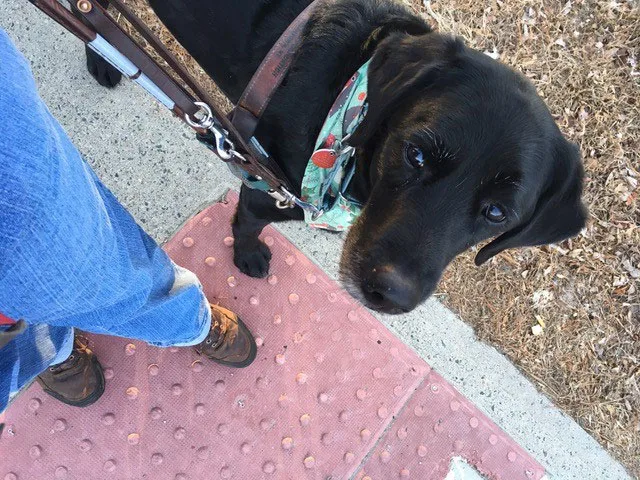
Like most working dogs, Tom loves to go to work every day.
“For these dogs it’s not work as in punching a time clock,” explains Katrin. “It’s work as in something they love, enjoy and have a strong desire to do. Think of it as work that fills your soul versus work that is just for a paycheque or means to an end.”
Katrin describes taking Tom out of his harness when they’re at one of the organizations where she volunteers.
Tom will walk around and request that people pet him. But after a little while, he returns to Katrin and tries to put his head back into his harness, seeming to say, “Okay, break is over, let’s get back to work.”
Katrin is quick to emphasize that Tom is also a regular dog who has lots of time off duty when he lounges on his dog beds or the couch, plays with Zora the Corgi, sniffs in the yard, chews toys, gets lots of petting “and generally does dog stuff.”
“It’s important to me that he gets time to do a wide variety of things he enjoys, not just guide dog work (which he very much enjoys),” she says.
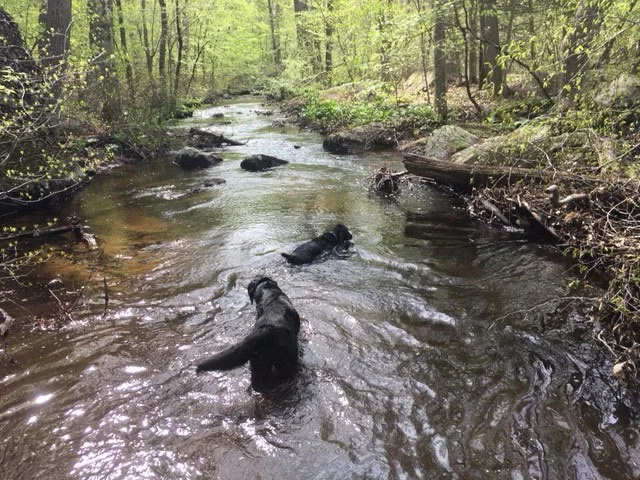
Katrin describes the human world as chaotic and stressful for many dogs and guide dogs have to not only cope but also find joy in these environments.
Downtime is very important for guide dogs to help them deal with working in public environments, which can be stressful for any dog, even for those who thrive in challenging situations.
What breeds are guide dogs?
Most guide dogs are bred for this specific line of work. The primary breeds used today in the U.S. are:
- Labrador Retrievers
- Golden Retrievers
- crosses of Labs and Goldens
- German Shepherds
- Standard Poodles
Katrin explains that “these breeds fall within the size range, temperament, general health, intelligence and adaptability criteria. With consistent types of dogs it also is easier for programs to share genetics with each other to improve the lines of dogs and prevent genetic bottlenecks.”
Other breeds of dogs can make excellent guide dogs, but it depends on the individual dog. Even with specific breeding, raising and training, guide dog programs estimate about 30% of dogs do not make it through formal training.
Reasons a dog may be career changed include medical, temperament or the dog making it clear they don’t love the work of a guide dog. These dogs are may be adopted as pets or go on to another working career such as becoming a drug or bomb dog.
How are guide dogs trained?
With more than 20 years of professional experience working with dogs, Katrin has a unique perspective on training guide dogs. In fact, she trained her first service dog, James, herself.
James was young, and Katrin had been training him for dog sports and working with him in many different environments when it became clear that she could benefit from a service dog. She trained him in the skills that she needed, and they were a successful partnership for 7 years.
However, Katrin knows that her experience with James was unusual.
Only a very small portion of the general dog population is suited to be a successful public access service dog. This is one of the reasons most guide dogs come from established breeding programs.
After James retired, Katrin tried to train another two new dogs for service, but each had to career change, one for medical reasons and the other for being unable to cope with the pressures of public access work.
Katrin then turned to the Guide Dog Foundation, an organization with then over 75 years of successful breeding, raising and training of guide dogs. It was there that she was matched with Tom.
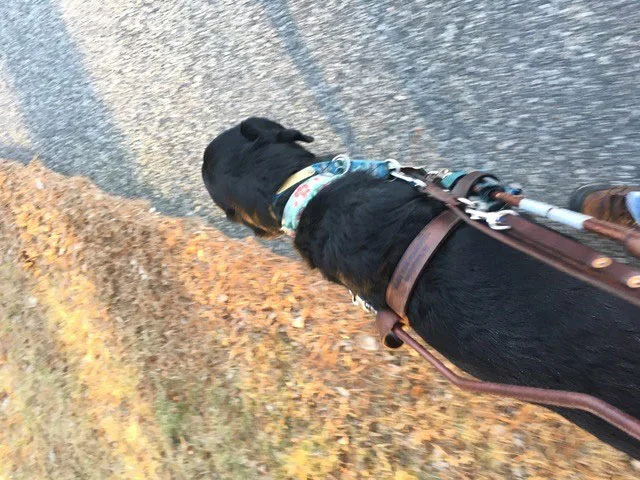
Qualities important for guide dogs
“Tom and other program bred guide dogs are unlike any other dogs I have ever had experience to work with,” she says.
“People are always asking me what breed he is, and I want to say, “he’s a guide dog” as I really feel they are a breed unto themselves. After so many generations of selective breeding, these dogs have … traits that lend them to be more successful in this line of canine career than other dogs.”
That success comes from a combination of nature and nurture.
Katrin provides a long list of some of the qualities that are important for guide dogs:
- high tolerance for novelty
- low noise sensitivity
- moderate to high pain tolerance
- excellent stress recovery
- high startle threshold
- excellent memory
- willingness to move in straight lines pulling into harness
- ability to comfortably adapt to changing environments
- low motion sensitivity
- low prey drive
- non-aggressive responses to rude behaviour (both human and animal)
- a default “leave it” behaviour
- well-mannered
- safe around the general public
- not viewed as an undue burden in places of business
- generally unobtrusive
- a desire to work with humans
Building on the foundation of the innate traits bred into the dogs, puppy raisers and trainers add the specific cues and trained behaviors to get a working guide dog.
See our post: How to become a guide dog puppy raiser
What commands do guide dogs learn?
Instructors at a formal training program usually teach such skills as:
- turning left
- right
- halt
- forward
- targeting curbs
- straight line travel
Another important concept is: “the perfect balance between responding to cues but also being willing to tell the handler no.”
This intelligent disobedience can be a literal life saver if the handler makes a mistake and asks the dog to lead them forward into traffic or off a train platform.
Matching a guide dog with a handler
An important part of helping a guide dog to be successful is also the match with the handler. Katrin explains that the training program labelled Tom as a city dog who would thrive in more active, intense, ever-changing city working environments.
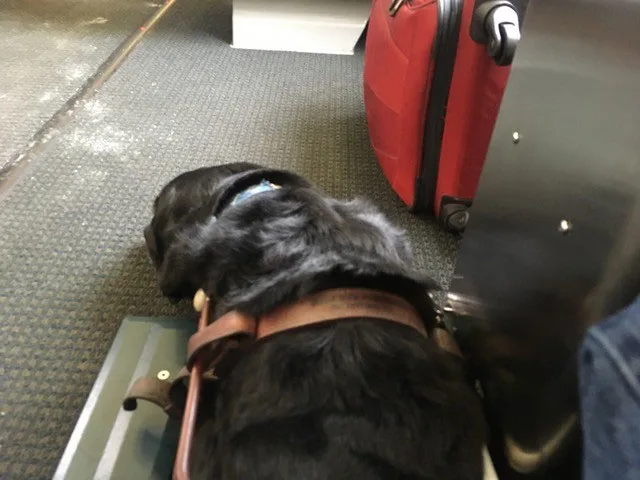
While Tom is responsible for helping Katrin, she also is responsible for him. “When my guide dog is in his harness, he’s working. Our relationship and navigating need to take top priority for us both. If he or I are distracted we both could end up injured or worse.”
Katrin and Tom encounter challenges every day. “When Tom moves a certain way I know there is another dog or person nearby that he doesn’t want anything to do with, and it’s my job to believe him and ensure he feels safe and heard,” she explains.
“My guide dog and our relationship are too valuable to be ruined by a poorly managed aggressive or rude dog or person. My ability to move safely and as freely as possible in the world depends so much on our partnership. Plus I love my dog too much to want him to be in a position where he feels unsafe.”
Katrin shares that numerous guide dogs have to be retired after being attacked by another dog or due to the stress from being repeatedly barked and lunged at by poorly managed dogs.
While other dogs can be difficult—and even dangerous—people can be equally challenging.
She offers an analogy to help understand her situation, “If you see a guide dog team out in the real world, please be respectful. I tell folks ‘imagine it’s not a dog but a wheelchair. Would you pet, grab or talk to a wheelchair? No? Then please don’t do it to a working guide dog. The team’s safety depends on it.’”
She also encounters people who don’t understand the work that Tom does.
“Sometimes people say, ‘Oh I wish I could bring my dog everywhere too!’ And I generally want to reality check [and say], ‘So you’d like everything that goes along with visual impairment and disability too?’” she says.
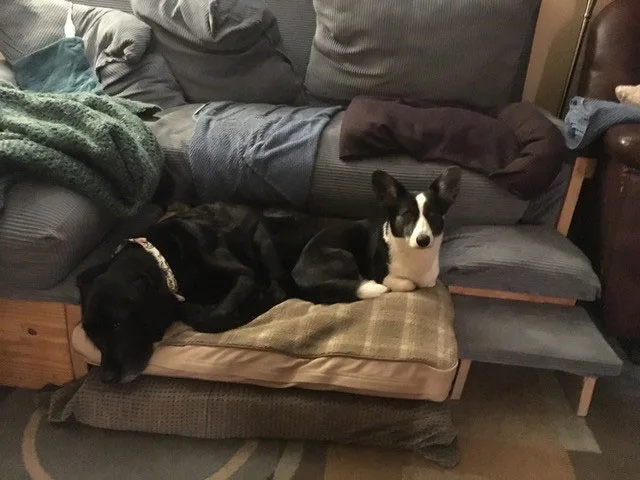
When do guide dogs retire?
Eight years into her partnership with Tom, Katrin is very proud of their bond. She says, “He’s continuing to tell me he enjoys being a guide dog still and he continues to be good at it.” When Tom retires, he will live the rest of his life with Katrin.
Guide dogs retire due to old age, medical issues, behavioral concerns or other reasons.
Katrin emphasizes that everyone involved with the dog, “from the person with disability to the program to the puppy raisers” work together to ensure the dog is taken care of for life in a loving home.
Sometimes handlers may be unable to keep their dogs (for example, if they live somewhere which does not allow pets, which is the legal description for a retired guide dog). Friends, family or the original puppy raisers may all have the option to adopt the dog.
“If none of those avenues are options, then guide dog programs generally have long lists of people wanting to adopt retired guide dogs,” Katrin explains.
Guide dogs are an incredibly important mobility aid, a living and breathing one who loves to go to work every day.
Katrin sums it up, “He’s not a pet, my guide dog is a huge part of my being as independent as I am and living the life I want.”
Katrin is a certified dog behavior consultant (CDBC, CBCC-KA) and has worked professionally in dogs for more than 20 years. She currently teaches a small number of dog training students, and volunteers with a few organizations she’s passionate about. She blogs about dogs, ducks, disability and more at maplewoodblog.
To learn more about guide dogs visit the Guide Dog foundation website at www.guidedog.org.
Do you have any experience with guide dogs? What impresses you most about guide dogs?
Julia Thomson is a blogger at Home on 129 Acres where she writes about her adventures of country living and DIY renovating. She and her family live on a 129-acre farm in Ontario, Canada. Follow Julia on Instagram here.
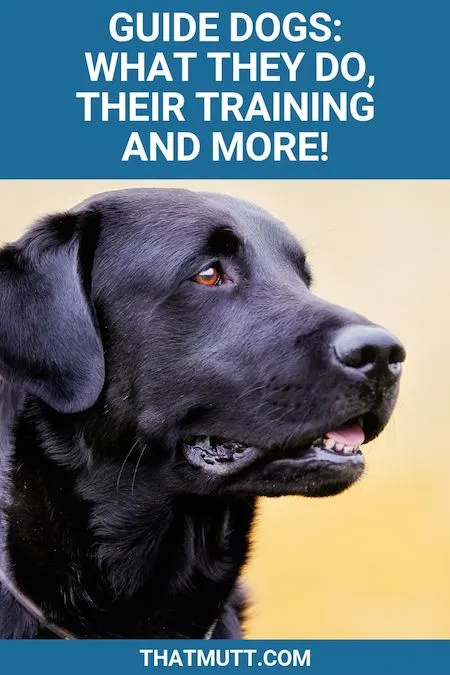

DONNA CARUSONE
Sunday 29th of May 2022
SO SAD, TIME FOR YOU TO GIVE AMERICAN STAFF, AKA , PIT BULL A CHANCE... SO SICK OF GOLDEN AND LABADOR. GETTING ALL THE CHANCES, AND YOU PEOPLE KNOW SO LITTLE ABOUT THIS BREED. EXTREMLY TRAINABLE.. LOYALL, LOVING.. POLICE DEPT HAVE STARTED TO USE THEM. BUT THEY CAN DO MORE THAN POLICE WORK WITH PROPER TRAINING... GIVE THESE DOGS A SHOT. I KNOW LONGER GIVE TO GUIDING EYES, BECAUSE THEY ARE STUCK ON ONE BREED. STOP THE STERIO TYPES..I'M NOT YOUNG. I'M 74, HAD PITTIES FOR 30 YEARS.. SO VERY, VERY, SAD....I 'M A BIG DOG LOVER, BUT THIS POOR BREED HAS BEEN KICKED TO THE CURB... SHOW SOCIETY HOW WRONG THEY ARE ABOUT THEM.. IT BEGINS WITH YOU. I HAVE MY 4TH PITTIE NOW... I ADOPTED HER 2 YEARS AGO... WE HAD PLANS OF SERVICE THRAINING THIS COMING SUMMER , WHEN MY SCHOOL JOB IS DONE.... SADLY SHE WAS DIANOISED WITH BLADDER CANCER, IN JANUARY... HER QUALITY OF LIFE IS STILL EXCELLENT, THANK GOD , BECAUSE SHE IS SUCH A GOOD GIRL, BUT NO ONE WILL TAKE US , BECAUSE SHE IS ON CHEMO THERAPATHY... I KNOW SHE IS GOING TO DIE, BUT SUCH A GOOD GIRL.... PLEAS GIVE THESE HOMELESS PITTIES A CHANCE... NOT ALL WILL MAKE IT..,, AS WITH ALL BREEDS.... IT'S TIME FOR A CHANGE...GIVE THEM A CHANCE... I KNOW MY GRACIE ROSE WOULD HAVE BEEN A GREAT THERAPY DOG IF TIME HAD GIVEN HER A CHANCE...
Nancy Stordahl
Tuesday 22nd of January 2019
I enjoyed reading this post and learning more about guide dogs. I'm always in awe when I see one out and about doing its job. I'm always struck by their calmness. I like how Katrin mentioned it's important to her that Tom gets time to do a wide variety of things he enjoys, not just guide dog work, though I'm sure he enjoys that most of all! Thank you for a very interesting read, Julia.
Beth
Monday 21st of January 2019
I really enjoyed reading about Tom and Karin. I've always aspired to be a puppy raiser for service dogs, but first I need to get my husband on board. I really loved her analogy about the wheelchair and guide dog. Sadly too many people don't seem to understand when a service dog is working, he needs to concentrate on his job.
Julia at Home on 129 Acres
Monday 21st of January 2019
I don't think I fully appreciated how important that concentration is until I spoke with Katrin. It's critical for her and Tom's safety that they not be distracted. I know I'm going to be much more conscious of my encounters with service dogs (with and without my dog) to make sure I'm not inadvertently creating a hazard.
Dorothy "FiveSibesMom"
Sunday 20th of January 2019
What great information on guide dogs you have shared. They have such an important job and it important for people to realize they are working, and as you said, someone would not go up and touch someone's wheelchair, so they should respect the working guide/service dog. I met a young girl who has epilepsy, and while I was chatting with her and her family about a seizure-alert dog they were looking into getting (she now has), I learned so much about what these dogs can do to help, and how much personalized training they receive. This particular one was in training for a year, then the girl and her family flew out to be trained with the dog for a couple weeks. You covered so much here, I am Pinning to share! Excellent post!
Julia at Home on 129 Acres
Sunday 20th of January 2019
It's amazing what dogs can sense and how those natural qualities can be developed into a working or service dog. I'm glad that this girl and her family were able to find a dog who was helpful to them. Thanks for sharing.
Carol Bryant
Sunday 20th of January 2019
I loved learning more about guide dogs. I know a cocker would likely be a bad candidate and I always wondered what qualities a dog for service like this should have. This is a great piece I am tweeting now, too.
Julia at Home on 129 Acres
Sunday 20th of January 2019
I think for guide dogs size is important. They have to be able to physically block their partner if needed and also have enough of a "presence" to navigate through crowds. Cockers would be a bit small for this, but definitely appropriate for other service jobs.
Lindsay Stordahl
Sunday 20th of January 2019
I bet there are a lot of cockers that are therapy dogs, though!